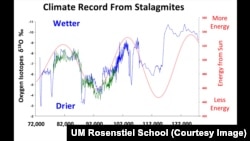A dry spell across the interior of the Middle East is unlikely to abate within the next 10,000 years, according to scientists who have been analyzing the chemical composition of two stalagmites collected from Qal’e Kord, a cave in north-central Iran.
Researchers at the University of Miami Rosenstiel School of Marine and Atmospheric Science took samples from different points along the stalagmites and dissolved the rock to release ancient carbon dioxide. Then they measured the oxygen within the CO2 and compared the ratio of heavier isotopes to lighter ones. A mix with fewer of the heavy oxygen isotopes was deposited during wetter time periods.
The mineral-laden drops of water that formed the 400mm and 440mm high spires contained a record of precipitation in the Middle East from 70,000 to 130,000 years ago.
Meteorological archive
That data helped scientists reconstruct the history of rainfall in the region over time. Paleoclimate PhD student Sevag Mehterian, lead author of the National Science Foundation-funded study, said cycles of wet and dry periods corresponded to the Earth’s angle to the sun and the amount of solar energy it received.
He said the Earth's orbit around the sun oscillates between elliptical and more circular.
"So as the Earth moved closer and further away from the sun in thousands of years' time periods, it would receive more energy, and this energy would actually be able to evaporate water in the Mediterranean Sea, and then it's that water that would eventually feed into the region of the Middle East as rainfall. So we saw precisely this kind of record in the stalagmites that we measured."
20,000-year cycle
This pattern, from maximum solar energy to today’s minimum and back, was a worldwide phenomenon, repeated roughly every 20,000 years. The researchers compared their findings to the numbers from the north Greenland ice core project and a deep-sea sediment record from the Atlantic, “and what we found was that we see the same exact record recorded in all of these different mediums in vastly different regions of the world."
And while it might seem that more solar energy would create a warmer, wetter world, Mehterian said there’s a difference between heat from outside the planet, and heat-trapping gases from the surface.
"It's a different mechanism of heating that's not able to actually warm up any of the water enough to evaporate in a way to actually deliver beneficial precipitation to the region."
The research was published in Quaternary Science Reviews.











